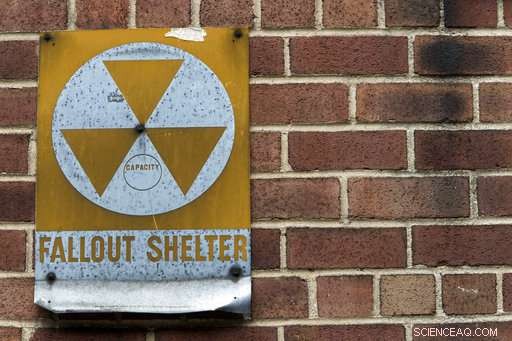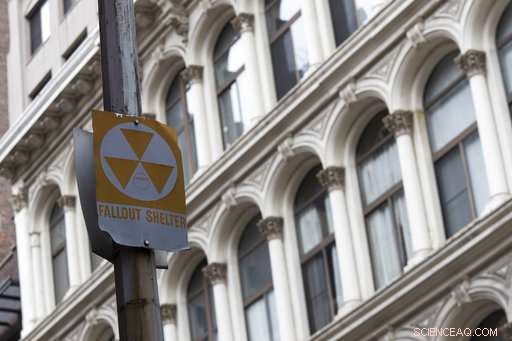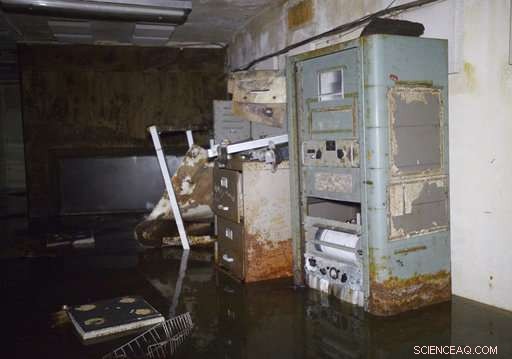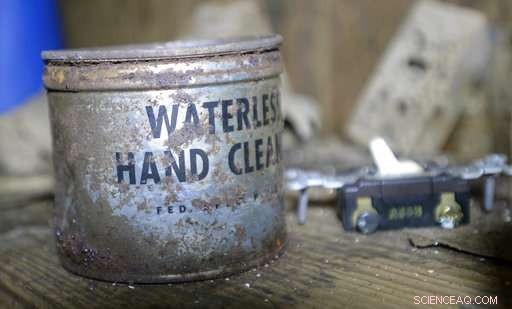
En ce mardi, 16 janvier photographies 2018, un signe d'abri antiatomique est accroché à un immeuble sur East 9th Street à New York. Les abris antiatomique, marqués de panneaux métalliques comportant le symbole des radiations – trois triangles joints à l'intérieur d'un cercle – ont été installés dans des dizaines de milliers de bâtiments à l'échelle nationale au début des années 1960 au milieu de la course aux armements nucléaires. Rien qu'à New York, il y en aurait environ 18, 000. (Photo AP/Mary Altaffer)
Une génération d'Américains savait exactement quoi faire en cas d'attaque nucléaire - ou lors d'une fausse alerte majeure, comme celui du week-end à Hawaï. Mettez-vous à l'abri dans un bâtiment portant un symbole jaune d'abri antiatomique.
Mais ces jours-ci, ce n'est peut-être pas la meilleure option, ou même une option du tout.
Reliques de la guerre froide, les refuges vieillissants qui se comptaient autrefois par milliers dans les écoles, les palais de justice et les églises n'ont pas été entretenus. Et la sagesse conventionnelle a changé quant à savoir si un tel système d'abris est nécessaire à une époque où une attaque est plus susceptible de provenir d'un État voyou faible ou d'un groupe terroriste plutôt que d'une superpuissance.
"Nous ne sommes pas dans un scénario de guerre froide. Nous sommes en 2018, " a déclaré le Dr Irwin Redlener, directeur du National Center for Disaster Preparedness de l'Earth Institute de l'Université Columbia. "Nous ne faisons pas face à ce que nous faisions il y a 50 ans, quand l'Union soviétique et les États-Unis avaient des ogives nucléaires pointées l'une sur l'autre qui dévasteraient le monde. Il y a une menace, mais c'est un type de menace différent aujourd'hui."
Les gens ne savaient pas quoi faire samedi lorsque Hawaï a envoyé par erreur une alerte de téléphone portable avertissant d'un missile balistique entrant et ne l'a pas rétracté pendant 38 minutes. L'État avait mis en place l'infrastructure d'alerte aux missiles après que la Corée du Nord eut démontré que ses missiles avaient la portée nécessaire pour atteindre les îles. Les conducteurs ont abandonné des voitures sur une autoroute et se sont réfugiés dans un tunnel. Des parents blottis dans des baignoires avec leurs enfants. Les étudiants ont traversé le campus de l'Université d'Hawaï pour se mettre à l'abri dans les bâtiments.

En ce mardi, 16 janvier photographies 2018, Des panneaux d'abri antiatomique sont accrochés à un lampadaire sur East 11th Street à New York. Dans une véritable frappe nucléaire, se mettre à l'abri dans un bâtiment portant le symbole jaune rouillé d'un abri anti-retombée n'est peut-être plus la meilleure option. Les experts disent que les abris dans les écoles et les palais de justice sont souvent des reliques vieillissantes de la guerre froide qui n'ont pas été entretenues. (Photo AP/Mary Altaffer)
La fausse alerte est le moment idéal pour parler de ce qu'il faut faire dans une telle urgence, Redlener a dit, car la plupart du temps, les gens ne veulent pas en parler. Du tout.
"Mais c'est une possibilité réelle, ", a-t-il déclaré. "Les responsables de la ville devraient parler de ce que leurs citoyens devraient faire si une attaque se produisait. Et c'est une nécessité pour les individus et les familles de parler et de développer leur propre plan de ce qu'ils feraient."
Les New-Yorkais qui ont été interrogés cette semaine sur l'endroit où ils chercheraient refuge lors d'une attaque au missile ont déclaré qu'ils n'avaient aucune idée.
"La seule chose à laquelle je pense, c'est je courrais, " a déclaré Sabrina Shephard, 45, de Manhattan. "Où nous courrions, Je ne sais pas, parce que je ne sais pas si New York a des abris anti-bombes ou quoi que ce soit."

En ce mardi, 26 septembre photos 2017, une baie de lits superposés peut être vue dans une pièce en forme de croissant à l'intérieur d'un bunker de la défense civile de l'époque de la guerre froide à la Nouvelle-Orléans. Une génération d'Américains savait exactement quoi faire en cas d'attaque nucléaire - ou lors d'une fausse alerte majeure, comme celui du week-end à Hawaï. Mettez-vous à l'abri dans un bâtiment portant un symbole jaune d'abri antiatomique. Mais ces jours-ci, ce n'est peut-être pas la meilleure option, ou même une option du tout. (Max Becherer / L'Avocat via AP)
Les abris antiatomique, marqués de panneaux métalliques comportant le symbole des radiations – trois triangles joints à l'intérieur d'un cercle – ont été installés dans des dizaines de milliers de bâtiments à l'échelle nationale au début des années 1960 au milieu de la course aux armements nucléaires. In New York City alone there were believed to be about 18, 000.
The locations were chosen because they could best block radioactive material. Anything could be a shelter as long as it was built with concrete, cinder blocks or brick, had no windows, and could be retrofitted quickly with supplies, an air filtration system and potable water.
But the idea was controversial from the start, especially since one of the scenarios at the time, a full-scale nuclear war between the U.S. and the Soviet Union, would have left few survivors. By the 1970s, the concept was abandoned. A FEMA spokeswoman said the agency doesn't even have current information on where the shelters are located.
New York City education officials announced last month they are taking down the fallout shelter signs at schools. In Minot, Dakota du nord, just a few miles from the base where dozens of U.S. missiles are at the ready, a few fallout shelter signs remain, but their status as viable refuges isn't known.

En ce mardi, 26 septembre photos 2017, a flashlight illuminates the main command center of a Cold War era Civil Defense bunker in New Orleans. The fallout shelters, marked with metal signs featuring the symbol for radiation - three joined triangles inside a circle - were set up in tens of thousands of buildings nationwide in the early 1960s amid the nuclear arms race. (Max Becherer /The Advocate via AP)
So what should you do if there is a nuclear attack now?
The good news:You may actually survive, because a nuclear attack today is more likely to be just one bomb—perhaps a small device, smuggled into a city inside a truck, or a single missile lobbed by North Korea that actually makes it across the water. The bad news:You have between 15 and 20 minutes to get to a safe space.
Eliot Calhoun, a disaster planner for New York's Emergency Management Department, said the smartest thing to do is stay put in a spot with as few windows and as many walls as possible.
"Don't go outside unless you absolutely must, " il a dit.

En ce mardi, 26 septembre photos 2017, old office equipment stands in a room near the entryway of a Cold War era Civil Defense bunker located in the neutral ground of West End Boulevard near Robert E. Lee Boulevard in New Orleans, La. Relics from the Cold War, the aging shelters that once numbered in the thousands in schools, courthouses and churches haven't been maintained. And conventional wisdom has changed about whether such a shelter system is necessary in an age when an attack is more likely to come from a weak rogue state or terrorist group rather than a superpower. (Max Becherer /The Advocate via AP)
Subterranean subway stations might be a good place to shelter if you happen to be in one when an attack happens, but experts say tunnels could also be dangerous if they are structurally compromised by a blast.
New Yorker Joe Carpenter emerged from a post office with a faded fallout shelter sign this week and admitted that he had never thought about what to do in the event of an incoming missile.
"I probably would just huddle with the masses and go along with the crowd, because I've never really considered it, " he said. "It's like everything else:Do we really ponder what's at the end of the road?"

En ce mardi, 26 septembre photos 2017, a container of waterless hand cleaner sits in a storage room inside an abandoned Cold War era Civil Defense bunker in New Orleans. Relics from the Cold War, the aging shelters that once numbered in the thousands in schools, courthouses and churches haven't been maintained. And conventional wisdom has changed about whether such a shelter system is necessary in an age when an attack is more likely to come from a weak rogue state or terrorist group rather than a superpower. (Max Becherer /The Advocate via AP)

En ce mardi, 26 septembre photos 2017, an infirmary complete with a medical bed and medical instruments is seen inside a Cold War era Civil Defense bunker in New Orleans. Relics from the Cold War, the aging shelters that once numbered in the thousands in schools, courthouses and churches haven't been maintained. And conventional wisdom has changed about whether such a shelter system is necessary in an age when an attack is more likely to come from a weak rogue state or terrorist group rather than a superpower. (Max Becherer /The Advocate via AP)

En ce mardi, 26 septembre photos 2017, Derek Boese, the Chief Administrative and Public Information Officer for the Southeast Louisiana Flood Protection Authority-East, uses a flashlight to illuminate the stair well of a Cold War era Civil Defense bunker in New Orleans. In a real nuclear disaster, taking cover in a building bearing a rusted yellow fallout shelter symbol may not be the best option anymore. Experts say the shelters in schools and courthouses are often aging relics from the Cold War that haven't been maintained. And conventional wisdom has changed. (Max Becherer /The Advocate via AP)

En ce mardi, Jan. 16, 2018 photo, a fallout shelter sign hangs on a building on East 9th Street in New York. A generation of Americans knew just what to do in the event of a nuclear attack—or during a major false alarm, like the one over the weekend in Hawaii. Take cover in a building bearing the yellow fallout shelter symbol. But these days, that might not be the best option, or even an option at all. (Photo AP/Mary Altaffer)
© 2018 La Presse Associée. Tous les droits sont réservés.